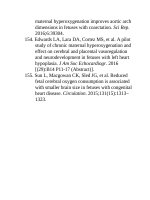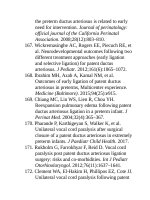Andersons pediatric cardiology 1928
Bạn đang xem bản rút gọn của tài liệu. Xem và tải ngay bản đầy đủ của tài liệu tại đây (124 KB, 3 trang )
atrium.389Thepediatricandadultcongenitalelectrophysiologysocietyandthe
HeartRhythmSocietyrecommendvitaminKantagonistsforIARToratrial
fibrillation.Warfarinisthepreferredagentoverthenewerdirectoral
anticoagulants(DOACs)suchasthedirectthrombininhibitors(dabigatran)or
factorXainhibitors(rivaroxaban,apixaban,andedoxaban).DOACsare
currentlynotrecommendedinthePediatricandAdultCongenital
ElectrophysiologySociety/HeartRhythmSocietyguidelinesduetothelackof
safetyandefficacydatainthesepatientswhoarepronetoliverdisease.390
AlthoughthereisgrowingexperiencewiththeuseofDOACsintheadult
congenitalpopulation,thereremainsverylittleexperienceintheFontan
population.391Patientswhoarenottakinganyformofthromboembolic
prophylaxisappeartobeathighestriskofthromboembolicevents.Inthe
absenceofclearindicationsforanticoagulation,aspirinandvitaminKinhibitors
appeartobeequallyefficaciousinreducingthromboembolicevents.134,296,392
Thereisgrowinginterestandexperienceintestingforaspirinresistancetohelp
guidethromboembolicprophylacticstrategyinFontanpatients.393However,
additionalstudiesareneededbeforetheutilityofthisapproachcanbe
recommended.
SurgicalManagementofFontanFailure
ThesurgicalmanagementofthefailingFontancirculationisdependentonthe
underlyingetiologyofthefailure.Commonproblemsthatmaybesurgically
addressedincludepathwayobstruction,atrioventricularorsemilunarvalve
regurgitation,bradycardiaorabsenceofsinusrhythm,andatrialarrhythmia.In
particular,patientswithatriopulmonaryconnectionswhohavearrhythmiaanda
dilatedrightatriummaybenefitfromtheFontanconversionprocedure.107
Patientswitha“failingFontan”whoarenotcandidatesforanyofthe
aforementionedbecauseofventriculardysfunctionmaybenefitfromheart
transplantation(seealsoChapter67).394Analysisofthesepatientsrequiresa
carefulmultidisciplinaryteamapproachthatincludesthecardiacsurgeon,
interventionalcardiologist,electrophysiologist,andthecardiactransplantteam.
Pathwayobstructionismostcommonlydealtwithintheinterventional
catheterizationlaboratorywithballoonangioplastyandstentplacement.
However,somecriticalstenosisnotrespondingtothesetherapiesmaybe
addressedbyconventionalsurgicaltechniquesusingconduitsand/orpatch
material.Patientswithsinusbradycardiaorjunctionalrhythmmaybenefitfrom
dualchamberpacemakerimplantation.Atranssternalapproachwithplacement
ofatrialandventricularbipolarsteroid-elutingepicardialleadsandapacemaker
generatorimplantedbeneaththerectusmusclemaybethepreferredoptionin
thesepatients.Achievingapacedsinusrhythmcanoftenincreasethecardiac
outputofthesepatientsby20%to30%.
ForthepatientpopulationwithanatriopulmonaryFontanwithdilatationof
therightatriumandeitheratrialreentrytachycardia,atrialfibrillation,orboth,
butwithpreservedventricularfunction,theFontanconversionoperationhas
beenquitesuccessful.ConversiontoanextracardiacFontanwitharrhythmia
surgery(biatrialmazeusingcryoablation)restoressinusrhythm,improvesflow
dynamics,andincreasescardiacoutput.Theoperationconsistsofresectionof
theenlargedrightatrium,creationofanatrialseptaldefect,biatrialmazewith
cryoablation,extracardiacGor-Texgraftfromtheinferiorcavalveintothemain
pulmonaryartery,bidirectionalsuperiorcavalpulmonaryanastomosis,and
placementofanepicardialdualchamberantitachycardiapacemaker.Thefinal
resultisillustratedinthecompletedFontanconversionpicture(Fig.73.28).395
Customizedpacemakertherapieswilloptimizemanagementofthepatients
followingFontanconversion.396Thelargestclinicalexperiencewiththis
procedureisattheAnn&RobertH.LurieChildren'sHospitalofChicago,
wherethistypeofFontanconversionhasbeenperformedin147patientsata
medianageof23years.Themajorityofrecentpatientshavebothatrialreentry
tachycardiaandatrialfibrillation.Theresultsofthisprocedureinproperly
selectedpatientsareexcellent,withanoperativemortalityof2.1%andmean
lengthofstayof13days.Riskfactorsforcardiacdeathortransplantationafter
Fontanconversionincluderightorindeterminateventricularmorphology,
preoperativeascites,orPLE,andacardiopulmonarybypasstimegreaterthan
240minutes.Intermediate-termresultsarealsofavorable,with84%aliveand
freefromtransplantationorarrhythmiarecurrenceat10years.
FIG.73.28 CompletedFontanconversion.Therightatriumhasbeen
reducedinsize.Therearebipolarepicardialpacingleadsontheright
atriumandtheanteriorsurfaceoftheventricle.APTFEgraftconnectsthe
inferiorcavalveinwiththepulmonaryartery.Thepulmonaryarteryhas
beenpatchedwheretheatriopulmonaryconnectionwastakendown.
Finally,thereisabidirectionalGlenn.(FromBackerCL,DealBJ,
MavroudisC,etal.ConversionofthefailedFontancirculation.Cardiol
Young.2006;16[suppl1]:85–91.)
ThenumberofpatientswithanatriopulmonaryFontanisdeclining,andin
survivors,morbidityisincreasingovertime.ItisapparentthattheFontan
conversionisbestdoneearlyinthecourseofFontanfailureandthatitisbest
doneincenterswiththeinstitutionalexperiencetodealwiththesecomplex
patients.Whenthisisthecase,astrategyofsurgicalconversionatanearlier
stageoffailuremaybeassociatedwithbettersurvivalfreefromheart
transplantation.397Forexample,inareportfromtheAustraliaandNewZealand
FontanRegistry,acentertakingaproactiveapproachwithrelativelyearly
Fontanconversionhadbetterresultsthancenterswhereconversionwasdelayed.
Attheproactivecenter,conversionwasundertakenatanaverageof2.9years
afterthefirstarrhythmiaepisodeandafteronecardioversion,whereastheother
centerswaitedanaverageof4.5yearsandtwocardioversions.Theearly
conversioncenterwasalsothehighestvolumecenter.Patientsatthiscenterhad
an86%freedomfromdeathortransplantationat10yearscomparedwith51%
forthoseattheothercenters(Fig.73.29).398Patientswithend-stageventricular
failure,PLE,plasticbronchitis,ascites,ormoderate-to-severeatrioventricular
valveregurgitationmayrequirehearttransplantation.Theoperativemortalityfor
hearttransplantationforpatientswithafailingFontanuntilrecentlywasquite









